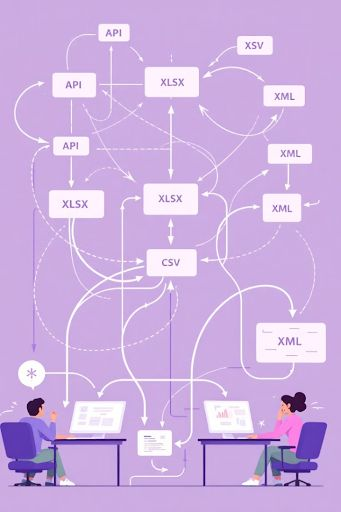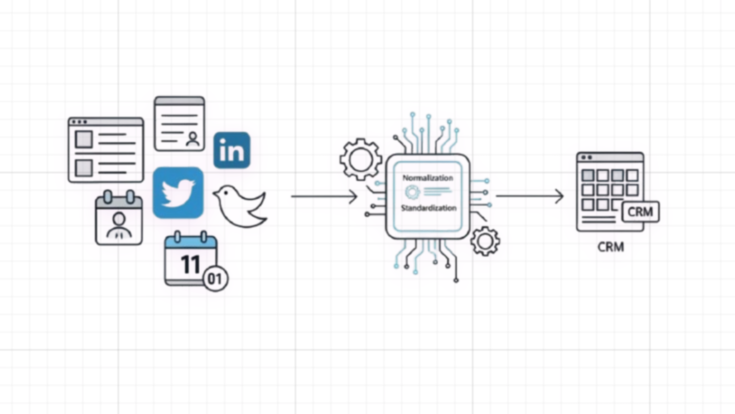Accelerate your growth by automating your data mapping and transformation: Empowering startups without engineering bottlenecks!

Who is this article for?
This article is designed for startups and growing businesses that are struggling with disorganized, inconsistent, or siloed data across various platforms. If your team spends too much time cleaning spreadsheets, dealing with data inconsistencies or lacking the engineering resources to streamline data processes, this guide is for you.
The data challenge startups face
In today's digital landscape, startups collect data from multiple sources such as CRMs, marketing platforms, and e-commerce tools. But integrating this data into one cohesive system is often a major hurdle. Common challenges include:
- Data silos make it difficult to perform comprehensive analysis.
- Inconsistent data formats cause integration complexity.
- Manual data handling introduces errors and inefficiencies.
- Lack of engineering resources limits the ability to build or maintain custom integrations.
These issues not only consume valuable time but also impede decision-making and growth.
The solution: How Zparse simplifies data mapping & transformation
Zparse offers a no-code, AI-powered ETL / Reverse ETL platform that empowers business users to:
- Automate Data Mapping: Seamlessly align data fields from various sources without manual intervention.
- Transform Data Efficiently: Convert data into the required formats, ensuring consistency and usability.
- Integrate Without Code: Connect multiple platforms and tools without writing a single line of code.
- Monitor Data Flows: Gain real-time visibility into your data workflows to ensure accuracy and reliability.
By eliminating the need for engineering support, Zparse enables teams to focus on strategic initiatives rather than data wrangling.
Key benefits of using Zparse
- Time savings: Automate repetitive tasks and free up hours every week.
- Improved data accuracy: Reduce manual errors through automated validation.
- Enhanced collaboration: Enable non-technical users to manage data flows independently.
- Scalability: Easily adapt to growing data needs without restructuring systems.
- Cost efficiency: Avoid expensive custom integrations and reduce hiring needs.
A startup's success stories
Marketing: Streamlining event lead integration
Challenge:
A marketing team frequently collected leads from various event platforms, but inconsistent field names and formats caused delays and syncing errors when syncing with their CRM.
Solution with Zparse:
- Automated mapping of disparate field names to the CRM's schema.
- Standardized data formats for seamless integration.
- Eliminated manual data cleaning processes.
Impact:
- Reduced lead processing time by 60%.
- Improved lead conversion rates by 25% due to faster follow-ups.
- Freed up 15 hours per week previously spent on manual data entry.
Operations: Harmonizing ERP and Shopify inventory data
Challenge:
The operations team struggled with syncing inventory data between their ERP system and Shopify store due to inconsistent values and varying data structures.
Solution with Zparse:
- Implemented AI-driven data transformation to align inventory data formats.
- Established real-time synchronization between ERP and Shopify.
- Provided visibility into data flows for proactive issue resolution.
Impact:
- Achieved 90% accuracy in inventory levels across platforms.
- Saved approximately 20 hours per month in manual reconciliation efforts.
Finance: Consolidating sales data across systems
Challenge:
The finance department faced difficulties in consolidating monthly sales data from multiple systems, each using different date and currency formats, leading to reporting delays and inaccuracies.
Solution with Zparse:
- Automated data extraction and transformation to standardize date and currency formats.
- Integrated data from various sources into a unified reporting structure.
- Enabled real-time data validation to ensure accuracy.
Impact:
- Cut down financial reporting time by 50%.
- Improved data accuracy, reducing errors in financial statements by 95%.
- Faster decisions and a measurable boost in operational efficiency.
How Zparse works
-
Step 1: Connect data sources: Sync and centralize data from Google Sheets, Shopify, ERP systems, and third-party SaaS tools.
-
Step 2: Automate data mapping: Review and validate AI-suggested mappings, making manual adjustments or defining custom field mappings.
-
Step 3: Clean, transform, and structure data: Effortlessly clean, transform, and structure data before ingestion
-
Step 4: Automate and monitor syncs: Schedule workflows, track data pipelines, and ensure real-time monitoring.
Conclusion
Clean, structured, well-mapped data should be the standard—not a luxury for teams with developers. Zparse makes data mapping and integration accessible, efficient, and accurate.
Because data should work for you. Not the other way around.


